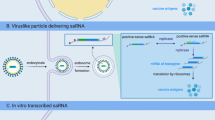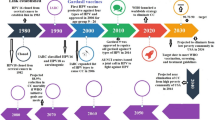Abstract
Human papillomavirus (HPV) is the causative agent of cervical cancer (CxCa) and the most commonly sexually transmitted pathogen worldwide. HPV type 16 (HPV-16) E7 oncoprotein is constitutively produced in CxCa and considered as a good antigen candidate for the development of new therapeutic CxCa vaccines. Here, we report the use of non-genetically modified, E7-expressing lactic acid bacteria (LAB) by using the cell-binding domain from Lactobacillus casei A2 phage lysin as a cell wall anchor. The versatility of this system was validated by investigating E7 stability at the surface of Lactococcus lactis and L. casei, two major species of LAB. Moreover, we demonstrated the successful use of these LAB displaying E7 antigen as a mucosal live vaccine in mice. Altogether, these results show the feasibility of using non-genetically modified LAB for low-cost mucosal immunotherapy against HPV-related CxCa in humans.






Similar content being viewed by others
References
Becker SC, Foster-Frey J, Stodola AJ, Anacker D, Donovan DM (2009) Differentially conserved staphylococcal SH3b_5 cell wall binding domains confer increased staphylolytic and streptolytic activity to a streptococcal prophage endolysin domain. Gene 443(1–2):32–41
Bermudez-Humaran LG, Langella P, Miyoshi A, Gruss A, Guerra RT, Montes de Oca-Luna R, Le Loir Y (2002) Production of human papillomavirus type 16 E7 protein in Lactococcus lactis. Appl Environ Microbiol 68(2):917–922
Bermudez-Humaran LG, Cortes-Perez NG, Le Loir Y, Alcocer-Gonzalez JM, Tamez-Guerra RS, de Oca-Luna RM, Langella P (2004) An inducible surface presentation system improves cellular immunity against human papillomavirus type 16 E7 antigen in mice after nasal administration with recombinant lactococci. J Med Microbiol 53(Pt 5):427–433
Bermudez-Humaran LG, Cortes-Perez NG, Lefevre F, Guimaraes V, Rabot S, Alcocer-Gonzalez JM, Gratadoux JJ, Rodriguez-Padilla C, Tamez-Guerra RS, Corthier G (2005) A novel mucosal vaccine based on live lactococci expressing E7 antigen and IL-12 induces systemic and mucosal immune responses and protects mice against human papillomavirus type 16-induced tumors. J Immunol 175(11):7297–7302
Cortes-Perez NG, Bermudez-Humaran LG, Le Loir Y, Rodriguez-Padilla C, Gruss A, Saucedo-Cardenas O, Langella P, Montes-de-Oca-Luna R (2003) Mice immunization with live lactococci displaying a surface anchored HPV-16 E7 oncoprotein. FEMS Microbiol Lett 229(1):37–42
Cortes-Perez NG, Azevedo V, Alcocer-Gonzalez JM, Rodriguez-Padilla C, Tamez-Guerra RS, Corthier G, Gruss A, Langella P, Bermudez-Humaran LG (2005) Cell-surface display of E7 antigen from human papillomavirus type-16 in Lactococcus lactis and in Lactobacillus plantarum using a new cell-wall anchor from lactobacilli. J Drug Target 13(2):89–98
de Ruyter PG, Kuipers OP, de Vos WM (1996) Controlled gene expression systems for Lactococcus lactis with the food-grade inducer nisin. Appl Environ Microbiol 62(10):3662–3667
Diaz E, Lopez R, Garcia JL (1990) Chimeric phage-bacterial enzymes: a clue to the modular evolution of genes. Proc Natl Acad Sci U S A 87(20):8125–8129
Drisko JA, Giles CK, Bischoff BJ (2003) Probiotics in health maintenance and disease prevention. Altern Med Rev 8(2):143–155
Feltkamp MC, Smits HL, Vierboom MP, Minnaar RP, de Jongh BM, Drijfhout JW, ter Schegget J, Melief CJ, Kast WM (1993) Vaccination with cytotoxic T lymphocyte epitope-containing peptide protects against a tumor induced by human papillomavirus type 16-transformed cells. Eur J Immunol 23(9):2242–2249
Garland SM, Smith JS (2010) Human papillomavirus vaccines: current status and future prospects. Drugs 70(9):1079–1098
Gasson MJ (1983) Plasmid complements of Streptococcus lactis NCDO 712 and other lactic streptococci after protoplast-induced curing. J Bacteriol 154(1):1–9
Hariharan K, Braslawsky G, Barnett RS, Berquist LG, Huynh T, Hanna N, Black A (1998) Tumor regression in mice following vaccination with human papillomavirus E7 recombinant protein in PROVAX. Int J Oncol 12(6):1229–1235
Hu S, Kong J, Kong W, Guo T, Ji M (2010) Characterization of a novel LysM domain from Lactobacillus fermentum bacteriophage endolysin and its use as an anchor to display heterologous proteins on the surfaces of lactic acid bacteria. Appl Environ Microbiol 76(8):2410–2418
Kuipers OP, de Ruyter PGGA, Kleerebezem M, de Vos WM (1998) Quorum sensing-controlled gene expression in lactic acid bacteria. J Biotechnol 64(1):15–21
Lin KY, Guarnieri FG, Staveley-O'Carroll KF, Levitsky HI, August JT, Pardoll DM, Wu TC (1996) Treatment of established tumors with a novel vaccine that enhances major histocompatibility class II presentation of tumor antigen. Cancer Res 56(1):21–26
Loessner MJ, Kramer K, Ebel F, Scherer S (2002) C-terminal domains of Listeria monocytogenes bacteriophage murein hydrolases determine specific recognition and high-affinity binding to bacterial cell wall carbohydrates. Mol Microbiol 44(2):335–349
Muderspach L, Wilczynski S, Roman L, Bade L, Felix J, Small LA, Kast WM, Fascio G, Marty V, Weber J (2000) A phase I trial of a human papillomavirus (HPV) peptide vaccine for women with high-grade cervical and vulvar intraepithelial neoplasia who are HPV 16 positive. Clin Cancer Res 6(9):3406–3416
Navarre WW, Schneewind O (1999) Surface proteins of gram-positive bacteria and mechanisms of their targeting to the cell wall envelope. Microbiol Mol Biol Rev 63(1):174–229
Pasetti MF, Simon JK, Sztein MB, Levine MM (2011) Immunology of gut mucosal vaccines. Immunol Rev 239(1):125–148
Preville X, Ladant D, Timmerman B, Leclerc C (2005) Eradication of established tumors by vaccination with recombinant Bordetella pertussis adenylate cyclase carrying the human papillomavirus 16 E7 oncoprotein. Cancer Res 65(2):641–649
Ribelles P, Rodriguez I, Suarez JE (2012) LysA2, the Lactobacillus casei bacteriophage A2 lysin is an endopeptidase active on a wide spectrum of lactic acid bacteria. Appl Microbiol Biotechnol 94(1):101–110
Schwarz E, Freese UK, Gissmann L, Mayer W, Roggenbuck B, Stremlau A, zur Hausen H (1985) Structure and transcription of human papillomavirus sequences in cervical carcinoma cells. Nature 314(6006):111–114
Sekine K, Toida T, Saito M, Kuboyama M, Kawashima T, Hashimoto Y (1985) A new morphologically characterized cell wall preparation (whole peptidoglycan) from Bifidobacterium infantis with a higher efficacy on the regression of an established tumor in mice. Cancer Res 45(3):1300–1307
Singh J, Rivenson A, Tomita M, Shimamura S, Ishibashi N, Reddy BS (1997) Bifidobacterium longum, a lactic acid-producing intestinal bacterium inhibits colon cancer and modulates the intermediate biomarkers of colon carcinogenesis. Carcinogenesis 18(4):833–841
Tokuyasu KT (1973) A technique for ultracryotomy of cell suspensions and tissues. J Cell Biol 57(2):551–565
Walboomers JM, Jacobs MV, Manos MM, Bosch FX, Kummer JA, Shah KV, Snijders PJ, Peto J, Meijer CJ, Munoz N (1999) Human papillomavirus is a necessary cause of invasive cervical cancer worldwide. J Pathol 189(1):12–19
Watterlot L, Meyrand M, Gaide N, Kharrat P, Blugeon S, Gratadoux JJ, Flores MJ, Langella P, Chapot-Chartier MP, Bermudez-Humaran LG (2010) Variations of N-acetylation level of peptidoglycan do not influence persistence of Lactococcus lactis in the gastrointestinal tract. Int J Food Microbiol 144(1):29–34
Yugawa T, Kiyono T (2009) Molecular mechanisms of cervical carcinogenesis by high-risk human papillomaviruses: novel functions of E6 and E7 oncoproteins. Rev Med Virol 19(2):97–113
Acknowledgments
The authors would like to thank Christine Longin (Unité UR1196 Génomique et Physiologie de la Lactation, INRA, Plateau de Microscopie Electronique—plate forme MIMA2-78352 Jouy-en-Josas cedex, France) for her precious help in immuno-electron microscopy experiments. We declare no conflict of interest.
Author information
Authors and Affiliations
Corresponding author
Additional information
Pedro Ribelles and Bouasria Benbouziane equally contributed to this paper.
Rights and permissions
About this article
Cite this article
Ribelles, P., Benbouziane, B., Langella, P. et al. Protection against human papillomavirus type 16-induced tumors in mice using non-genetically modified lactic acid bacteria displaying E7 antigen at its surface. Appl Microbiol Biotechnol 97, 1231–1239 (2013). https://doi.org/10.1007/s00253-012-4575-1
Received:
Revised:
Accepted:
Published:
Issue Date:
DOI: https://doi.org/10.1007/s00253-012-4575-1




